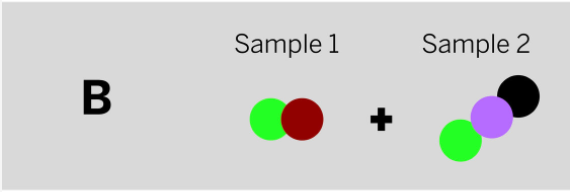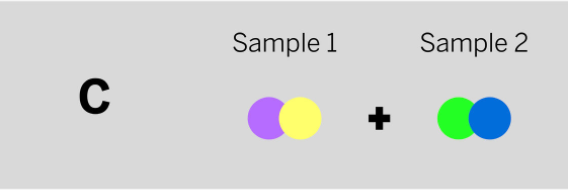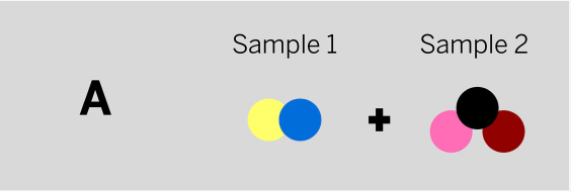
Chemical Reactions Amplify
Quiz
•
Science
•
7th Grade
•
Hard
+1
Standards-aligned

Lisa Thompson
FREE Resource
Enhance your content
15 questions
Show all answers
1.
MULTIPLE CHOICE QUESTION
1 min • 1 pt

Jamie works at a company that makes cleaning chemicals. She is trying to make a chemical that smells like flowers. She took two samples that were gases at room temperature and mixed them in a sealed container. The diagram above shows the repeating groups of atoms that make up the two starting substances.
After mixing, Jamie found two substances that smelled like flowers in the sealed container. (Nothing had escaped.) Which of the diagrams to the left shows the repeating groups of atoms that make up the ending substances?




Tags
NGSS.MS-PS1-1
NGSS.MS-PS1-2
NGSS.MS-PS1-5
2.
MULTIPLE CHOICE QUESTION
1 min • 1 pt

A chemist mixed two samples together: a gray liquid that boils at 103°C and a colorless gas that boils at 19°C. She analyzed the results and found two ending substances. One of the ending substances was a pink liquid. This ending substance is made up of the repeating group of atoms shown above. Which of the diagrams to the left shows the repeating groups of atoms that make up the samples the chemist mixed together?




Tags
NGSS.MS-PS1-1
NGSS.MS-PS1-2
NGSS.MS-PS1-5
3.
MULTIPLE CHOICE QUESTION
1 min • 1 pt

Patrik works at a company that makes paper and needs a chemical to make the paper brighter. He mixed two colorless substances together in a sealed container. The diagram above shows the repeating groups of atoms that make up the two starting substances.
After mixing, Patrik found two white substances in the sealed container. (Nothing had escaped.) Which of the diagrams to the left shows the repeating groups of atoms that make up the ending substances?




Tags
NGSS.MS-PS1-1
NGSS.MS-PS1-2
NGSS.MS-PS1-5
4.
MULTIPLE CHOICE QUESTION
1 min • 1 pt

Serena mixed two samples together: a gray solid that smells like flowers and a gray solid that smells like bleach. She analyzed the results and found two ending substances. One of the ending substances was a white solid. This ending substance is made up of the repeating group of atoms shown above. Which of the diagrams to the left shows the repeating groups of atoms that make up the samples Serena mixed together?




Tags
NGSS.MS-PS1-1
NGSS.MS-PS1-2
NGSS.MS-PS1-5
5.
MULTIPLE CHOICE QUESTION
1 min • 1 pt

Marisol mixed two samples together: a brown liquid with no smell and a colorless gas that smells irritating. She analyzed the results and found two ending substances. One of the ending substances smelled sweet. This ending substance is made up of the repeating group of atoms shown above. Which of the diagrams to the left shows the repeating groups of atoms that make up the samples Marisol mixed together?




Tags
NGSS.MS-PS1-1
NGSS.MS-PS1-2
NGSS.MS-PS1-5
6.
MULTIPLE CHOICE QUESTION
1 min • 1 pt

Andres is a chemist working at a company that makes ink. To make a new kind of ink, Andres mixed two liquid substances together in a sealed container. The diagram above shows the repeating groups of atoms that make up the two starting substances.
After mixing, Andres found two solid substances in the sealed container. (Nothing had escaped.) Which of the diagrams to the left shows the repeating groups of atoms that make up the ending substances?




Tags
NGSS.MS-PS1-1
NGSS.MS-PS1-2
NGSS.MS-PS1-5
7.
MULTIPLE CHOICE QUESTION
1 min • 1 pt

Samira watched a demonstration in which a scientist combined two substances in a sealed container and analyzed the results. The ending substances did not look the same as the starting substances. Samira was given a diagram with the repeating groups of atoms that make up the starting substances, plus information about the properties of the starting and ending substances. She created a model of the repeating groups of atoms that might make up the two ending substances.
Samira's model correctly demonstrates how the properties changed with the rearrangement of the atoms. However not all atoms are accounted for. There is a missing reactant.
Samira's model is correct because the properties are different and the atoms are rearranged.
Samira's model is incorrect because not all atoms are accounted for
Samira's model correctly demonstrates how the properties changed with the rearrangement of the atoms. However not all atoms are accounted for. There is a missing product.
Tags
NGSS.MS-PS1-1
NGSS.MS-PS1-2
NGSS.MS-PS1-5
Create a free account and access millions of resources
Create resources
Host any resource
Get auto-graded reports

Continue with Google

Continue with Email

Continue with Classlink

Continue with Clever
or continue with

Microsoft
%20(1).png)
Apple
Others
By signing up, you agree to our Terms of Service & Privacy Policy
Already have an account?
Similar Resources on Wayground

18 questions
Chemical Reaction Amplify
Quiz
•
8th Grade

10 questions
Chemical Reactions
Quiz
•
7th Grade

13 questions
Amplify Chemical Reaction
Quiz
•
7th - 8th Grade

13 questions
Amplify Chemical Reaction Test
Quiz
•
7th - 8th Grade

13 questions
Chemical Reaction Amplify
Quiz
•
7th - 8th Grade

13 questions
The Diagram Above Shouts the Repeating Atoms That Make Up Two Samples. Will the Properties of the Two Samples Be the Sam
Quiz
•
8th Grade

12 questions
Chapter 2 Amplify Chemical Reactions
Quiz
•
7th Grade

18 questions
Chemical Reactions
Quiz
•
8th Grade
Popular Resources on Wayground

20 questions
Brand Labels
Quiz
•
5th - 12th Grade

10 questions
Ice Breaker Trivia: Food from Around the World
Quiz
•
3rd - 12th Grade

25 questions
Multiplication Facts
Quiz
•
5th Grade

20 questions
ELA Advisory Review
Quiz
•
7th Grade

15 questions
Subtracting Integers
Quiz
•
7th Grade

22 questions
Adding Integers
Quiz
•
6th Grade

10 questions
Multiplication and Division Unknowns
Quiz
•
3rd Grade

10 questions
Exploring Digital Citizenship Essentials
Interactive video
•
6th - 10th Grade
Discover more resources for Science

20 questions
Distance Time Graphs
Quiz
•
6th - 8th Grade

26 questions
7.6E Rate of Dissolution
Quiz
•
7th Grade

17 questions
Energy Transformations
Quiz
•
6th - 8th Grade

10 questions
Exploring Newton's Laws of Motion
Interactive video
•
6th - 10th Grade

17 questions
Thermal Energy Transfer
Lesson
•
6th - 8th Grade

10 questions
Exploring Chemical and Physical Changes
Interactive video
•
6th - 10th Grade

20 questions
Photosynthesis and Cellular Respiration
Quiz
•
7th Grade

25 questions
Cell Structure
Lesson
•
7th Grade







